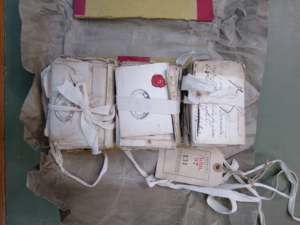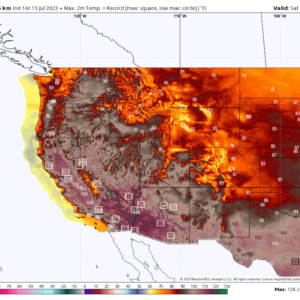A million deaths in the United States has created a desire for the country to commemorate their lives and “democratize grief.” But how and where should a monument be built—and who should pay for it?
As the United States nears 1 million deaths from Covid-19, a movement is growing to memorialize the astronomical loss of life and preserve their legacies.
Marked By Covid—a San Francisco-based nonprofit cofounded by Kristin Urquiza, who lost her 65-year-old father to Covid in June 2020—is campaigning to establish a federally recognized national holiday to memorialize victims of the pandemic. The grassroots organization is also working with cities nationwide to create physical monuments, as well as an augmented reality component dedicated to those who have been lost.
Marked By Covid’s proposal calls for local communities to install scalable monuments that can be customized to fit a community’s budget and available land. Urquiza—who famously addressed the 2020 Democratic National Convention and declared that her father’s “only preexisting condition was trusting Donald Trump”—believes the pandemic has created a need to “democratize grief” and acknowledge what the country has been through. By comparison, the 1918 Spanish flu claimed an estimated 675,000 American lives (at a time when the U.S. population was 105 million), but given that it coincided with World War I, few memorials commemorate the dead.
“We cannot forget this tragedy,” says the 40-year-old Urquiza. “We owe it to the million people who lost their lives to remember and pass down to future generations the hard truth of our lived experience to prevent a tragedy like this from ever happening again.”
The Marked By Covid monument prototype consists of a small plinth with four accessible ramps that can be customized depending on its location. Based on the renderings, the base can be used as a place to lay flowers, photographs and candles to remember loved ones. The prototype was co-created with artist Marcos Lutyens and founder Brad Wolfe, whose nonprofit Reimagine helps people confront death and grief.

The organization has also proposed an augmented reality component that would allow visitors to use a smartphone or other mobile device to upload images and information of loved ones to the virtual helix. Urquiza says the AR component is “a really powerful way to capture this moment” when so much of people’s day-to-day life is taking place virtually.
The cost of such an adaptable memorial is still being explored, but Urquiza says a recent projection for Los Angeles was estimated at just under $1 million. The group is already in talks with the state of New Mexico, Fairfax County, Virginia, and Reno, Nevada, about the possibility of installing monuments in part, Urquiza says, to “fight revisionist history about the gravity of the situation.”
“I feel strongly that if we push this tragedy into the memory hole that we are doomed to repeat the same mistakes again,” she continues. “I’m worried not just about a future pandemic. I’m worried about our preparedness for future public health crises, like climate change.” Urquiza says she hopes to see a national memorial commemorating the pandemic one day, but says that, for now, Marked By Covid is focusing on local monuments.

The first permanent memorial for Covid-19 victims was established last year at a farm in Wall Township, New Jersey, by Rima Samman, who lost her 40-year-old brother, Rami, to the virus in May 2020. The early days of the pandemic left Samman’s family unable to be with him during the final weeks of his life, hold a proper funeral or meet with relatives to mourn. In January 2021, for what would have been Rami’s 41st birthday, Samman organized a small event to take rocks she hand-painted yellow and arrange them in a heart on the beach in Belmar, New Jersey. After the event, Samman posted online offering to add stones with the names of other Covid-19 victims for people who could not attend. The next morning, Samman said she woke up to nearly 200 messages from people requesting stones. “And then the names just kept coming,” Samman says.
Soon, people were traveling hundreds of miles to visit the makeshift memorial on the New Jersey beach, and Samman says she’s received messages from people as far away as Japan. Within 45 days, the memorial included stones with about 2,000 names arranged into 10 hearts, Samman says. By May 2021, the hearts–at that point, made up of 3,000 names–were relocated from the beach after Samman faced pressure from the city to move the stones with the summer beach season approaching. Thanks to $50,000 in donations, Samman’s homemade memorial was permanently relocated to Allaire Community Farms in Wall Township, New Jersey, where Samman and her nonprofit organization, Rami’s Heart, continue to add more names, which now number about 6,000. Samman says the memorial has received thousands of visitors since the relocation last July.
Samman has appealed to politicians to make the memorial at the farm a national monument and to raise more funds to continue adding names and maintain it. The rapid growth of her memorial shows the yearning for a national pandemic memorial, Samman says. “Grieving is already a difficult process to go through. But [with Covid-19] there’s trauma involved. These families need to heal, and they need this.”
Here’s how some other famous national monuments and memorials came to pass:

The National September 11 Memorial in Manhattan commemorates both the September 11, 2001, attacks that killed 2,977 people and the 1993 World Trade Center bombing, in which 6 people died. The $700 million cost in 2014 (about $840 million today) was covered by contributions from government agencies and donations from private individuals. (Former New York Mayor Michael Bloomberg, who serves as the memorial’s chairman, personally donated $30 million, a representative told the New York Times last year.)
The complex, located at Ground Zero, is made up of a street-level memorial with two reflecting pools that mark where the Twin Towers once stood, and a subterranean museum with thousands of artifacts related to the terrorist attacks. While the memorial plaza is open to the public, the museum charges $26 for admission, waived for 9/11 survivors, their families and first responders. In 2014, it was estimated that operating the complex would cost $63 million a year. The institution was left with an $18 million deficit in 2020 after the pandemic forced the museum to shut and then limit capacity the previous year. This week, officials from the the 9/11 Tribute Museum—a separate and smaller institution that focuses on the community of survivors—said they would likely close after racking up too much debt during the coronavirus pandemic, according to the Wall Street Journal.

The Vietnam Veterans Memorial in Washington, D.C. lists the names of the 58,318 Americans who died over the eight years the United States fought the war. According to a 1983 report from the Vietnam Veterans Memorial Fund, the project cost $3.9 million (or $11.3 million today). By 1981, the group had raised about $8.4 million, thanks to donations from some 245,000 Americans, along with gifts from veterans groups, corporations, labor unions and other organizations. Designed by Maya Lin, a then 21-year-old Yale undergraduate who won a nationwide contest, the memorial was controversial when it was dedicated in 1982. The V-shaped slab of sunken black granite was devoid of any patriotic symbols or heroic imagery associated with war memorials. Three years later, a statue of three soldiers facing the wall by sculptor Frederick Hartwas—who called Lin’s initial design “nihilistic” —was built on the site to appease critics. Lin’s memorial has since become one of America’s most popular monuments and attracts millions of visitors each year.

The Oklahoma City Memorial marks the bombing of the Alfred P. Murrah Federal Building and surrounding structures on April 19, 1995, the deadliest act of domestic terrorism in U.S. history. The memorial complex—which includes a museum, a reflecting pool, and a field of 168 empty chairs representing victims of the attack—was dedicated in 2000 and cost $29.1 million (or $48.9 million today). More than $17 million came from private donations, along with $7 million from the state and $5 million in federal funds. An international competition for the design was won by Hans and Torrey Butzer, a husband-and-wife design team from Germany who decided to relocate to Oklahoma permanently after working on the project.

Dedicated in 1995, the Korean War Veterans Memorial in Washington,D.C.,was covered entirely by donations. Of the $18 million cost (or $34 million today) more than $13 million came from U.S. veterans of the Korean War, while South Korean companies, including Hyundai and Samsung, donated $2.5 million and American companies gave $1 million toward the cost of the memorial. (Samsung donated an additional $1 million in 2015 for the monument’s upkeep.) The site features 19 larger-than-life statues of soldiers meant to represent a patrolling platoon with distinguishing features of the different U.S. military branches, and features a triangular mural with images of troops who fought in the war sandblasted into black granite. With the reflections of the statues in the granite, viewers can see 38 statues, a symbol of the 38 months the war lasted and the 38th Parallel, the border between North and South Korea before the war.

Opened in 2004, the World War II Memorial in Washington, D.C. consists of a semicircle of 56 pillars—representing a different U.S. state or territory —and two triumphal arches for the Atlantic and Pacific battle theaters surrounding a plaza with a fountain. The design was criticized upon its unveiling, with Washington Post columnist Marc Fisher writing that the structure had “the emotional impact of a slab of granite.” Concerns were also raised that the monument’s location on the National Mall—between the Lincoln Memorial and the Washington Monument—compromised the view from those two historic sites. The monument cost about $182 million ($278.8 million today) but a fundraising campaign brought in more than $197 million from hundreds of thousands of individual donations and gifts from many companies. The remaining funds were held in a trust to go toward the upkeep of the monument and the Federal Government contributed about $16 million. The memorial features two engravings of Kilroy, a doodle of a man with a large nose peeking over a wall that commonly appeared in graffiti among U.S. military members during the 1940s. The cartoon was usually drawn with the phrase “Kilroy was here.”


The Statue of Liberty was dedicated in 1889 in New York City as a gift from the people of France. The statue cost the French government an estimated $250,000, or $5 million today. Lady Liberty’s $100,000 pedestal was financed through donations by individual Americans, with most gifts made up of $1 or less. The 151-foot-tall statue is of Libertas, the Roman goddess of freedom, shown holding a torch in one hand and a tablet with July 4, 1776—the day the Declaration of Independence was adopted. A broken shackle and chain lying at her feet represented the abolition of slavery in the U.S. in 1866. The copper statue, which was visited by a record 60 million people in 2016, was designed by French sculptor Frédéric Auguste Bartholdi while its iron framework was built by French engineer Alexandre-Gustave Eiffel, who would soon go on to design an eponymous tower in Paris.




